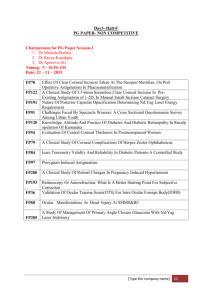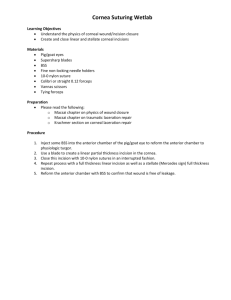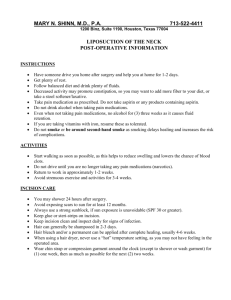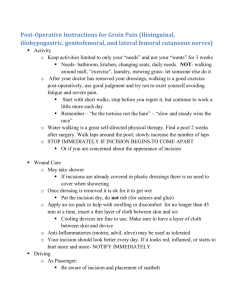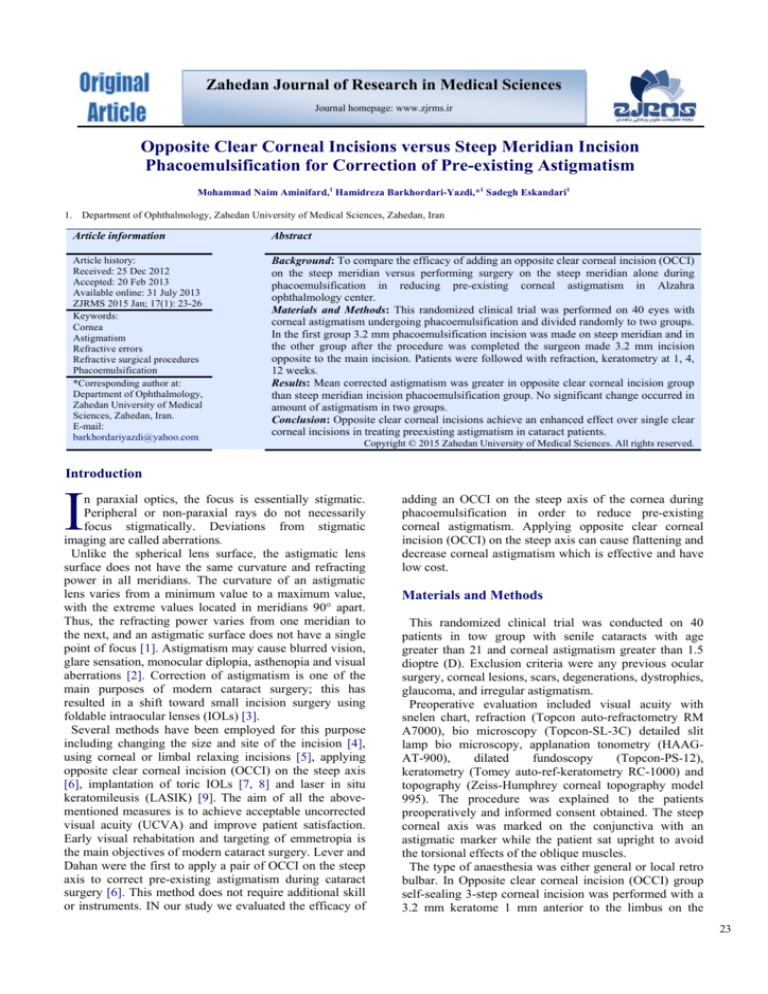
Zahedan Journal of Research in Medical Sciences
Journal homepage: www.zjrms.ir Opposite Clear Corneal Incisions versus Steep Meridian Incision
Phacoemulsification for Correction of Pre-existing Astigmatism
Mohammad Naim Aminifard,1 Hamidreza Barkhordari-Yazdi,*1 Sadegh Eskandari1
1. Department of Ophthalmology, Zahedan University of Medical Sciences, Zahedan, Iran
Article information
Abstract
Article history:
Received: 25 Dec 2012
Accepted: 20 Feb 2013
Available online: 31 July 2013
ZJRMS 2015 Jan; 17(1): 23-26
Keywords:
Cornea
Astigmatism
Refractive errors
Refractive surgical procedures
Phacoemulsification
*Corresponding author at:
Department of Ophthalmology,
Zahedan University of Medical
Sciences, Zahedan, Iran.
E-mail:
barkhordariyazdi@yahoo.com
Background: To compare the efficacy of adding an opposite clear corneal incision (OCCI)
on the steep meridian versus performing surgery on the steep meridian alone during
phacoemulsification in reducing pre-existing corneal astigmatism in Alzahra
ophthalmology center.
Materials and Methods: This randomized clinical trial was performed on 40 eyes with
corneal astigmatism undergoing phacoemulsification and divided randomly to two groups.
In the first group 3.2 mm phacoemulsification incision was made on steep meridian and in
the other group after the procedure was completed the surgeon made 3.2 mm incision
opposite to the main incision. Patients were followed with refraction, keratometry at 1, 4,
12 weeks.
Results: Mean corrected astigmatism was greater in opposite clear corneal incision group
than steep meridian incision phacoemulsification group. No significant change occurred in
amount of astigmatism in two groups.
Conclusion: Opposite clear corneal incisions achieve an enhanced effect over single clear
corneal incisions in treating preexisting astigmatism in cataract patients. Copyright © 2015 Zahedan University of Medical Sciences. All rights reserved.
Introduction
I
n paraxial optics, the focus is essentially stigmatic.
Peripheral or non-paraxial rays do not necessarily
focus stigmatically. Deviations from stigmatic
imaging are called aberrations.
Unlike the spherical lens surface, the astigmatic lens
surface does not have the same curvature and refracting
power in all meridians. The curvature of an astigmatic
lens varies from a minimum value to a maximum value,
with the extreme values located in meridians 90° apart.
Thus, the refracting power varies from one meridian to
the next, and an astigmatic surface does not have a single
point of focus [1]. Astigmatism may cause blurred vision,
glare sensation, monocular diplopia, asthenopia and visual
aberrations [2]. Correction of astigmatism is one of the
main purposes of modern cataract surgery; this has
resulted in a shift toward small incision surgery using
foldable intraocular lenses (IOLs) [3].
Several methods have been employed for this purpose
including changing the size and site of the incision [4],
using corneal or limbal relaxing incisions [5], applying
opposite clear corneal incision (OCCI) on the steep axis
[6], implantation of toric IOLs [7, 8] and laser in situ
keratomileusis (LASIK) [9]. The aim of all the abovementioned measures is to achieve acceptable uncorrected
visual acuity (UCVA) and improve patient satisfaction.
Early visual rehabitation and targeting of emmetropia is
the main objectives of modern cataract surgery. Lever and
Dahan were the first to apply a pair of OCCI on the steep
axis to correct pre-existing astigmatism during cataract
surgery [6]. This method does not require additional skill
or instruments. IN our study we evaluated the efficacy of
adding an OCCI on the steep axis of the cornea during
phacoemulsification in order to reduce pre-existing
corneal astigmatism. Applying opposite clear corneal
incision (OCCI) on the steep axis can cause flattening and
decrease corneal astigmatism which is effective and have
low cost.
Materials and Methods
This randomized clinical trial was conducted on 40
patients in tow group with senile cataracts with age
greater than 21 and corneal astigmatism greater than 1.5
dioptre (D). Exclusion criteria were any previous ocular
surgery, corneal lesions, scars, degenerations, dystrophies,
glaucoma, and irregular astigmatism.
Preoperative evaluation included visual acuity with
snelen chart, refraction (Topcon auto-refractometry RM
A7000), bio microscopy (Topcon-SL-3C) detailed slit
lamp bio microscopy, applanation tonometry (HAAGAT-900),
dilated
fundoscopy
(Topcon-PS-12),
keratometry (Tomey auto-ref-keratometry RC-1000) and
topography (Zeiss-Humphrey corneal topography model
995). The procedure was explained to the patients
preoperatively and informed consent obtained. The steep
corneal axis was marked on the conjunctiva with an
astigmatic marker while the patient sat upright to avoid
the torsional effects of the oblique muscles.
The type of anaesthesia was either general or local retro
bulbar. In Opposite clear corneal incision (OCCI) group
self-sealing 3-step corneal incision was performed with a
3.2 mm keratome 1 mm anterior to the limbus on the
23 Zahedan J Res Med Sci 2015 Jan; 17(1): 23-26
steep axis. After viscoelastic injection, a similar incision
was made opposite the first incision on the steep axis to
enhance flattening of the cornea for correction of the preexisting astigmatism. One incision was used for
phacoemulsification, and the other was left unused, and in
second group phacoemulsification incision was made in
steep meridian.
A standard conventional phacoemulsification was
performed followed by bimanual irrigation/aspiration then
foldable posterior chamber intraocular lens implantation
inside the capsular bag. At the end of the operation only
the irrigation/aspiration incisions were hydrated. All the
patients received routine postoperative topical steroids
and antibiotics eye drops for 5 th weeks. They were
examined at the first and 4th and 12 week postoperatively.
During the follow up period, all the patients were assessed
for best corrected visual acuity, refraction, keratometry,
and topography. Statistical analysis was performed with
preoperative and postoperative topographic keratometric
reading using simple subtraction with the mean and
standard deviation and compare data with paired t-test in
SPSS-16 program. p≤0.05 was statistically significant. Results
The two study groups did not differ significantly in
terms of age and sex (data not presented).
Figure 1 summarizes pre- and postoperative visual
acuity in study groups which had not significantly
difference. Mean corrected visual acuity at 1 week was
significantly better in occi group (p=0.01). Mean UN
corrected visual acuity at 4 week was significantly better
in occi group (p=0.01). Mean UN corrected visual acuity
at 12 week was significantly better in occi group
(p=0.007).
Figure 2 summarizes pre-operative astigmatism in study
groups which had not significantly difference. Postoperative residual astigmatism in steep incision group was
significantly greater than occi group at 1 week (p=0.005).
Post-operative astigmatism in steep incision group was
significantly greater than occi group at 4 week (p=0.001)
Post-operative astigmatism in steep incision group was
significantly greater than occi group at 12 week
(p=0.001).
Figure 3 summarizes pre-operative keratometry in study
groups which had not significantly difference. Postoperative keratometry in steep incision group was
significantly greater than occi group at 1 week (p=0.001).
Post-operative keratometry in steep incision group was
significantly greater than occi group at 4 week (p=0.002).
Post-operative keratometry in steep incision group was
significantly greater than occi group at 12 week (p=0.01).
Figure 1. Mean visual acuity in simple incision and occi group preoperation, 1, 4 and 12 week
Figure 2. Mean residual cylinder in simple incision and occi group preoperation, 1, 4 and 12 week
24
Opposite clear corneal incisions versus steep meridian incision for correction astigmatism
Aminifard MN et al.
Figure 3. Mean k reading in simple incision and occi group preoperation, 1, 4 and 12 week
Discussion
In our study mean corrected astigmatism was greater in
opposite clear corneal incision group than steep meridian
incision phacoemulsification group. No significant change
occurred in amount of astigmatism in two groups.
Astigmatism can correct with glass, contact lens or
surgery in regular pattern and with contact lens in
irregular pattern. Most cause of astigmatism is cornea and
with the rule astigmatism [1] astigmatism correction done
with flattening in steep meridian [10].
Post-operative residual astigmatism in steep incision
group was significantly greater than occi group. So
corrected astigmatism in occi group was greater than
steep incision group.
Patients undergoing cataract surgery expect clear vision
and less dependence on spectacles. To attain this goal,
one important consideration is reduction of astigmatism.
Modern cataract surgery using small incisions and
foldable IOLs has led to achieving emmetropia in a great
number of patients. Modifications in surgical technique
and incisions may further improve refractive outcomes by
reduction of astigmatism. Different methods have been
used to correct pre-existing astigmatism during cataract
surgery. Making the incision on the steep corneal axis is
the simplest method but may be difficult or impossible
with certain axes. The amount of correction using this
method varies but is usually reported to be less than 1 D.
Astigmatic keratotomy, is another alternative which
entails drawbacks such as glare sensation, diplopia and
fluctuation of refractive error due to proximity of the
incisions to the center cornea. In addition, it requires
preoperative pachymetry and use of a diamond knife.
Corneal relaxing incisions are another method for
correction of pre-existing corneal astigmatism;
advantages include being technically easy, producing
fewer symptoms, earlier wound stabilization due to the
location of the incision and inducing no change in
spherical equivalent when 2 incisions are made due to
coupling effect. However, this method also suffers from
limitations such as requiring pachymetry and use of a
diamond knife, in addition to controversies regarding
application of the nomogram. Implantation of toric IOLs
is another option, however these lenses are expensive and
their implantation requires additional skills; moreover,
postoperative rotation remains a major drawback.
Excimer laser ablation may also be used to correct
residual or induced astigmatism after cataract surgery.
Major concerns include the cost of the procedure, limited
number of canters equipped with excimer machines,
adverse effects specific to excimer laser surgery such as
loss of BCVA, flap related complications, night vision
disturbances and regression.
Lever and Dahan reported 33 patients that 3.5 mm
opposite clear cornea incisions straddling the steep axis
decreased pre-existing astigmatism by a mean value of 2
D [6]. Corresponding figures using this method have been
reported to be 1.5 D by Khokhar et al. [11].
In contrast to the previously mentioned methods, paired
OCCI on the steep axis is technically easy without need
for additional equipment. The same 3.2 mm knife used by
most surgeons for routine phacoemulsification cataract
surgery is used for making both incisions and therefore no
additional cost is entailed. This method is effective for
correction of mild to moderate corneal astigmatism, but in
eyes with higher degrees of astigmatism it is
recommended to use an alternative method or a
combination of two or more methods.
25 Zahedan J Res Med Sci 2015 Jan; 17(1): 23-26
Some authors recommend a larger clear cornea incision
on the steep axis to increase the effect of the procedure
while temporary sutures are placed for closing the wound.
Disadvantages of this method include the increased risk of
endophthalmitis due to the penetrating nature of the
incisions as compared to non-penetrating methods. For
control of leakage in this method one can use nylon
sutures for wound closure.
Qmar and Mullaney reported 15 patients that 3.5 mm
opposite clear cornea incisions straddling the steep axis
decreased pre-existing astigmatism by a mean value of 2
D [12] and 0.5 D by Tadros et al. [13].
Zemaitiene et al. reported 28 patients that 4 mm
opposite clear cornea incisions straddling the steep axis
and 9 patients that 3 mm opposite clear cornea incisions
straddling the steep axis decreased pre-existing
astigmatism [14]. Bazzazi et al. reported that 3.5 mm
opposite clear cornea incisions straddling the steep axis
decreased pre-existing astigmatism [15]. Zare et al.
reported that limbal relaxing decreased pre-existing
astigmatism [16].
The two study groups did not differ significantly in
terms of age and sex. Pre- and postoperative visual acuity
in study groups had not significantly difference. Mean
corrected visual acuity at 1 week was significantly better
in occi group. Mean UN corrected visual acuity at 4 week
was significantly better in occi group. Mean UN corrected
visual acuity at 12 week was significantly better in occi
group.
Pre-operative astigmatism in study groups had not
significantly
difference.
Post-operative
residual
astigmatism in steep incision group was significantly
References
1. Richard A. Clinical optics. USA: Slack; 2008: 116-124.
2. Rashand KM. Laser in situ keratomileusis for myopic
astigmatism. J Refract Surg. 1999; 15(6): 653-660.
3. Hoffer KJ. Biometry of 7500 cataractous eyes. Am J
Ophthalmol. 1980; 90(3): 360-368.
4. Akura J, Kaneda S, Hatta S and Matsuura K. Controlling
astigmatism in cataract surgery requiring relatively large
self-sealing incisions. J Cataract Refract Surg. 2000;
26(11): 1650-1659.
5. Muller-Jensen K, Fisher P, Siepe U. Limbal relaxing
incisions to correct astigmatism in clear corneal cataract
surgery. J Refract Surg. 1999; 15(5): 586-589.
6. Lever J, Dahan E. Opposite clear corneal incision to
correct preexisting astigmatism in cataract surgery. J
Cataract Refract Surg. 2000; 26(6): 803-805.
7. Till JS, Yoder PR Jr, Wilcox TK and Spielman JL. Toric
intraocular lens implantation: 100 consecutive cases. J
Cataract Refract Surg. 2002; 28(2): 295-301.
8. Rushwurm I, Scholz U, Zehetmayer M. Astigmatism
correction with a foldable toric intraocular lens in cataract
patients. J Cataract Refract Surg. 2000; 26(7): 1022-1027.
9. Yang CN, Shen EP, Hu FR. Laser in situ kerotomileusis
for the correction of myopia and myopic astigmatism. J
Cataract Refract Surg. 2001; 27(12): 1952-1960.
10. Richard E. Medical cornea-corneal and refractive surgery.
Amsterdam: Kugler Pubns B V; 1994: 65-85.
greater than occi group at 1 week. Post-operative
astigmatism in steep incision group was significantly
greater than occi group at 4 week. Post-operative
astigmatism in steep incision group was significantly
greater than occi group at 12 week. Pre-operative
keratometry in study groups had not significantly
difference. Post-operative keratometry in steep incision
group was significantly greater than occi group at 1 week.
Post-operative keratometry in steep incision group was
significantly greater than occi group at 4 week. Postoperative keratometry in steep incision group was
significantly greater than occi group at 12 week.
In conclusion, paired opposite clear corneal incisions on
the steep axis are useful for correcting mild to moderate
pre-existing astigmatism during cataract surgery.
Employing
this
technique
during
routine
phacoemulsification using a 3.2 mm incision does not
require additional instruments and therefore can be
performed without altering the surgical setting.
Acknowledgements
This research project (code 425T) has been done by Dr
Eskandari in Zahedan University of Medical Sciences.
Authors’ Contributions
All authors had equal role in design, work, statistical
analysis and manuscript writing.
Conflict of Interest
The authors declare no conflict of interest.
Funding/Support
Zahedan University of Medical Sciences.
11. Khokhar S, Lohiya P, Murugiesan V and Panda A.
Corneal astigmatism correction with opposite clear corneal
incisions or single clear corneal incision: Comparative
analysis cataract. J Cataract Refract Surg. 2006; 32(9):
1432-7.
12. Qmar A, Mullaney P. Paired opposite clear corneal
incisions to correct preexisting astigmatism in cataract
patients. J Cataract Refract Surg. 2005; 31(6): 1167-70.
13. Tadros A, Habib M, Tejwani D, et al. Opposite clear
corneal incisions on the steep meridian in
phacoemulsification: Early effect on the cornea. J Cataract
Refract Surg. 2004; 30(2): 414-7.
14. Zemaitiene R, Jasinskas V, Januleviciene I. [Correction of
corneal
astigmatism
during
phacoemulsification]
Lithuanian [Abstract]. Medicina (Kaunas). 2003; 39(12):
1175-83.
15. Bazzazi N, Barazandeh B, Kashani M and Rasouli M.
Opposite clear corneal incisions versus steep meridian
incision phacoemulsification for correction of pre-existing
astigmatism. J Ophthalmic Vis Res. 2008; 3(2): 87-90.
16. Zare M, Hosseini-Tehrani M, Gohari M, et al.
Management of corneal astigmatism by limbal relaxing
incisions during cataract surgery. Iran J Ophthalmol. 2010;
22(1): 15-20.
Please cite this article as: Aminifard MN, Barkhordari-Yazdi H, Eskandari S. Opposite clear corneal incisions versus steep meridian incision
phacoemulsification for correction of pre-existing astigmatism. Zahedan J Res Med Sci. 2015; 17(1): 23-26.
26

